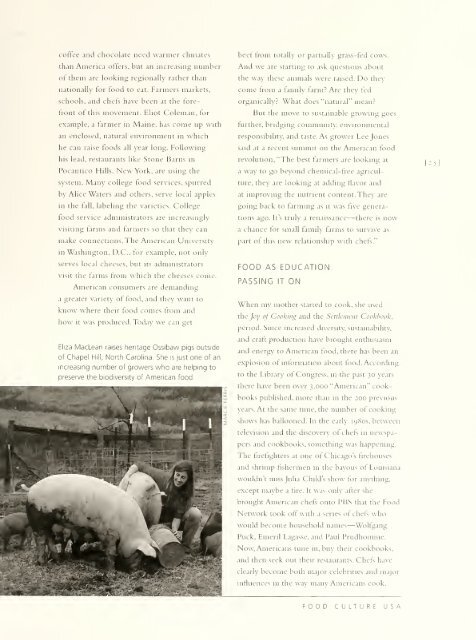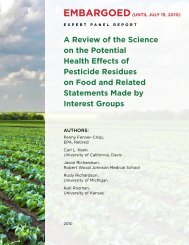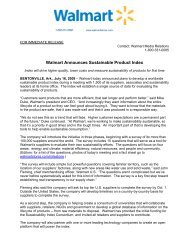ISustainable farmers such as Eliot Coleman are proving that locally grown food is viable in allclimates. Here, Coleman harvests lettuce at his Four Season Farm in Harborside, MaineThe host of companies specializing in craftand sustainable production keeps expanding. Steve)emos, founder oí Silk Soy, started out makingsoy milk at a local fanners market in Boulder,< ni. irado. Michael Cohen started peddling tempeliin 1974 by a 25-year-old hippie and sixtunecollege dropout named |ohn Mackev.who opened the Safer Way, then one ot 25health food stores m Austin, Texas. Today,while most ot those other 24 health foodstores are defunct, Sater W.iv has grown intofor Lite Lite, abrand now owned by ConAgra. Henthe largest chain ot grocerystores with anCohen and [erry Greenfield propelled then peaceand love ice cream to the mainstream. StonyfieldFarm yogurt, Annie's Homegrown pasta, and( alitornia's Earthbound Farms all sell throughnational chains. ( lone are the days of unappetizingmacrobiotics, brown nee, and totu. A wholeindustry has arisen making veggie burgers andmeatless sausage and salami, Tofurkys tor vegetarianThanksgh ing dinners, and "not dogs" and "phonybaloncv" all out or soy. While 25 years ago healthconsciousness was the domain of the counterculture,and vegetarianism and food coops were a signot pacifism, today they have become mainstream.An increasing number ot companies andretailers have pioneered nationwide markets.organic slant in the country. Whole Foods,with [65 stores coast to coast, are in mainplaees where there is rarely a hippie in sight.The retailer is now the leading outlet foragrowing number of national brands thatshare the store's commitment to health andsustainability. Whole Foods has also spurredother supermarkets to stock their shelveswith a growing number ot organic products.This combination ot environmental stewardship,flavor, and health is quietly buildingup around the country in schools, neighborhoods,and cities. As globalism increases inour kitchens and supermarkets, there iscountervailing trend of people who want toa1 he health-food mass movement was startedsee what can be produced intheir area ot thecountry. Most people realize, ot course, thatSMITHSONIAN FOLKLIFE FESTIVAL
eet from totally or partially grass-fed cows.And we are starting to ask questions aboutthe way these animals were raised. Do theycome from a family farm? Are they fedorganically? What does "natural" mean'coffee and chocolate need warmer climatesthan America otters, but an increasing numberof them are looking regionally rather thannationally for food to eat. Farmers markets,schools, and chefs have been at the forefrontof thismovement. Eliot Coleman, forBut the move to sustainable growing goesexample, a farmer in Maine, has come up withan enclosed, natural environment in whichfurther, bridging community, environmentalresponsibility, and taste. As grower Lee Joneshe can raise foods all year long. Followingsaid at arecent summit on the American foodhis lead, restaurants like Stone Barns inPocantico Hills, New York, are using thesystem. Many college food services, spurredrevolution, "The best farmers are looking ata way to go beyond chemical-free agriculture,they are looking at adding flavor andby Alice Waters and others, serve local applesatimproving the nutrient content. They arein the tall, labeling the varieties. Collegefood service administrators are increasinglygoing back to farming as it was five generationsago. It's truly a renaissance—there is nowvisiting farms and farmers so that they canachance tor small family farms to survive asmake connections. The American Universityin Washington, D.C., for example, not onlypart of thisnew relationship with chefs."serves local cheeses, but its administratorsvisit the farms from which the cheeses come.American consumers are demandingagreater variety of food, and they want toknow where their food comes from andhow itwas produced. Today we can getEliza Maclean raises heritage Ossibaw pigs outsideof Chapel Hill, North Carolina. She is just one of anincreasing number of growers who are helping topreserve the biodiversity of American food.FOOD AS EDUCATION:PASSING IT ONWhen my mother started to cook, she usedthe Joy of Cooking and the Settlement Cookbook,period. Since increased diversity, sustainability,and craft production have brought enthusiasmand energy to American food, there has been anexplosion of information about food. Accordingto the Library of Congress, in the past 30 yearsthere have been over 3,000 "American" cookbookspublished, more than in the 200 previousyears. At the same time, the number of cookingshows has ballooned. In the early19x0s, betweentelevision and the discovery of chefs innewspapersand cookbooks, something was happening.The firefighters at one of Chicago's tirehousesand shrimp fishermen in the bayous of Louisianawouldn't miss [uliaChild's show for anything,except maybe a tire. It was only after shebrought American chets onto PBS that the FoodNetwork took oft with aseries ot chefs whowould become household names—WolfgangPuck, Emeril Lagasse, and Paul Prudhonime.Now, Americans tune in, buy their cookbooks,and then seek out their restaurants. Chefs haveclearly become both major celebrities and majorinfluences in the way many Americans cook.FOOD CULTURE USA
- Page 1: Smithsonianolklife Festival\Food Cu
- Page 4 and 5: The annual Smithsonian Folklite Fes
- Page 7 and 8: —CONTENTSThe Festival's Timely Ap
- Page 9 and 10: —THE FESTIVAL'S TIMELY APPEALLAWR
- Page 11 and 12: COMMERCE FOR CULTUREFrom the Festiv
- Page 13 and 14: [ii]The food concession for the Mel
- Page 15 and 16: oMiiitbioni.indotal SoundL04.A 1 Sl
- Page 17: 1WELCOME TO THE 2005 FOLKLIFE FESTI
- Page 20 and 21: Workers harvest artichokes at Ocean
- Page 22 and 23: —assigned aparticular dish—meat
- Page 24 and 25: I--IPot Pie Farm manager Elizabeth
- Page 28 and 29: "IThe numberof programsdesignedfor
- Page 30 and 31: .hadSALAD GREENS WITH GOAT CHEESE,
- Page 32 and 33: w.A>wm:~
- Page 34 and 35: —3 3]OCCUPATIONAL CULTUREThe 2005
- Page 36 and 37: employees, the USDA Forest Servicei
- Page 38 and 39: I[3 6]page book, which could fit in
- Page 40 and 41: ká.!i- .>!mKPA backpacker sets up
- Page 42 and 43: --^i'liunterw eight jihI ...itl jib
- Page 44 and 45: —4-"The essentialpiece isto captu
- Page 46 and 47: I44cutDUTCH OVENONE-POT MEALThomas
- Page 48 and 49: —FUTURE CONCERNS FOR PUBLIC LANDS
- Page 50 and 51: NUESTRA MÚSICA: MUSIC INBuilding C
- Page 52 and 53: plena groups throughout the Northea
- Page 54 and 55: NUESTRA MÚSICA LAUNCHES NEW SERIES
- Page 56 and 57: NUESTRA MÚSICA: MUSIC IN LATINO CU
- Page 58 and 59: "ILos Camperos de Valles son músic
- Page 60 and 61: RAICES LATINASNUESTRA MÚSICA LANZA
- Page 63 and 64: IOMAN: DESERT, OASIS, AND SEARICHAR
- Page 65 and 66: DESERTThe deserts ot the Arabian Pe
- Page 67 and 68: THE FESTIVAL PROGRAMThe 200s Smiths
- Page 70 and 71: 6 8The coiled, leather-covered bask
- Page 72 and 73: 70]COASTAL CRAFTSMANSHIPAND GLOBAL
- Page 74 and 75: [72]Although the oldismaking way fo
- Page 76 and 77:
AN OMANI FOLKTALEASYAH AL-BUALYOman
- Page 79 and 80:
y%aMUSIC AND DANCE INOMANOMAN CENTR
- Page 81:
In the southern Dhufar region, al-b
- Page 84 and 85:
ecosystems, identification of plant
- Page 86 and 87:
2:00IIIVorkshopFESTIVAL SCHEDULE (P
- Page 88 and 89:
Rhythm,Saturday, June 25 (Programs
- Page 90 and 91:
)avidi nestMonday, June 27(Programs
- Page 92 and 93:
1:00IIlamFriday, July 1 (Programs a
- Page 94 and 95:
)utchSunday, July 3(Programs are su
- Page 96 and 97:
EVENING CONCERTSSounds of the Fores
- Page 98 and 99:
theRELATED EVENTS[96]Nuestra Músic
- Page 100 and 101:
IIDónalas Anderson,Washington, D.C
- Page 102 and 103:
'IEd LiíDmi, Studio City, Californ
- Page 104 and 105:
ISudhir Seth, Bethesda, MarylandA g
- Page 106 and 107:
1 if 1 DumberHoneyBeehive Beeproduc
- Page 108 and 109:
1"''NewI >onI Lui\IDon Bustos,Espa
- Page 110 and 111:
Ian Barlow, White Bird,Idaho; Woodl
- Page 112 and 113:
I 'istnet1Gordon Grant,Corvallis, O
- Page 114 and 115:
Kristen Marline, Flagstaff,Arizona;
- Page 116 and 117:
I1 ountries,IIHistorie Site, once t
- Page 118 and 119:
1IworksI1 11Istations are vital to
- Page 120 and 121:
1'IenIpanderetas;JCJ Band. Washingt
- Page 122 and 123:
Ralph Rinzlersongs are "made" (or c
- Page 124 and 125:
I >cmseI VhorahII MiI lameEne Nance
- Page 126 and 127:
|i 2forIIBartlevy1 )oerr;IIParadeSP
- Page 128 and 129:
II AerialIIII1Washington and Jeffer
- Page 130 and 131:
Stack, Bill Stafford, loni Stafford
- Page 132 and 133:
SMITHSONIAN FOLKLIFE FESTIVAL 20051
- Page 135 and 136:
SMITHSONIAN FOLKLIFE FESTIVAL 2005B
- Page 138:
Smithsonian Folklife FestivalSMITHS








